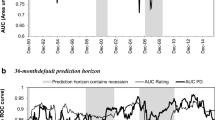Abstract
The Basel II Advanced Internal Ratings (AIRB) approach is compared to capital requirements set using an equilibrium structural credit risk model. Analysis shows the AIRB approach undercapitalizes credit risk relative to regulatory targets and allows wide variation in capital requirements for a given exposure owing to ambiguity in the definitions of loss given default and exposure at default. In contrast, the Foundation Internal Ratings Based (FIRB) approach may over-capitalize credit risk relative to supervisory objectives. It is unclear how Basel II will buttress financial sector stability as it specifies the weakest regulatory capital standard for large complex AIRB banks.
Similar content being viewed by others
References
Basel Committee on Banking Supervision: Basel II: international Convergence of Capital Measurement and Capital Standards: A Revised Framewor. Bank for International Settlements, June (2004). Available at http://www.bis.org.
Basel Committee on Banking Supervision: Overview Paper for the Impact Study. Bank for International Settlements, October (2002). Available at http://www.bis.org
Basel Committee on Banking Supervision: The Internal Ratings-Based Approach Consultative Document. Bank for International Settlements, May (2001). Available at http://www.bis.org.
Basel Committee on Banking Supervision: Capital Requirements and Bank Behavior: The Impact of the Basel Accord. BCBS Working Paper No. 1, Bank for International Settlements (1999). Available at http://www.bis.org.
Basel Committee on Banking Supervision: Results of the fifth quantitative impact study (QIS 5). Bank for International Settlements, June (2006a). Available at http://www.bis.org.
Basel Committee on Banking Supervision: International Convergence of Capital Measurement and Capital Standards: A Revised Framework Comprehensive Version. Bank for International Settlements, June (2006b). Available at http://www.bis.org.
Black F., Cox J.C. (1976) Valuing Corporate Securities: Some Effects of Bond Indenture Provisions. J Financ 31, 351–367
Black F., Scholes M. (1973) The pricing of options and corporate liabilities. J Polit Econ 81, 637–54
Eom Y., Helwege J., Huang J.-z. (2004) Structural Models of Corporate Bond Pricing: An Empirical Analysis. Rev Financ Stud 17, 499–544
Gordy M. (2003) A risk-factor model foundation for ratings-based bank capital rules. J Financ Intermed 12, 199–232
Greenspan, A.: Remarks by Chairman Greenspan before the Conference on Capital Regulation in the 21st Century. New York: Federal Reserve Bank of New York, February 26, 1998.
Finger, C.: Conditional approaches for CreditMetrics portfolio distributions. CreditMetrics Monitor, 14–33 (1999)
Notice of proposed rule making to implement Basel II risk-based capital requirements in the United States for large internationally active banking organizations, March 30, 2006. available at http://www.federalreserve.gov/generalinfo/basel2/default.htm
Jackson P., Perraudin W., Saporta V. (2002) Regulatory and “economic” solvency standards for international active banks. J Bank Financ 26, 953–973
Jones D. (2000) Emerging problems with the Basel Capital Accord: Regulatory capital arbitrage and related issues. J Bank Financ 24, 35–58
Jones E.P., Mason S., Rosenfeld E. (1984) Contingent Claims Analysis of Corporate Capital Structures: An Empirical Investigation. J Financ 39, 611–625
Federal Deposit Insurance Corporation: History of the Eighties – Lessons for the Future. Volume I: An Examination of the Banking Crisis of the 1980s and Early 1990s. Washington D.C.: Federal Deposit Insurance Corporation (1997)
Kupiec P. (2004a) Estimating economic capital allocations for market and credit risks. J Risk 6, 4
Kupiec, P.: Capital Adequacy and Basel II. FDIC CFR Working paper No. 2004–02 (2004b) available at http://www.fdic.gov
Kupiec, P.: Basel II: A Case for Recalibration. J Financ Services Res (2006) (in press)
Merton R. (1974) On the pricing of corporate debt: The risk structure of interest rates. J Financ 29, 449–70
Myer, L.: Remarks by Governor Laurence H. Myer at the Risk Management Association’s Conference on Capital Management. Washington D.C., May 17, (2001)
Ogden J. (1987) Determinants of the Ratings and Yields on Corporate Bonds: Tests of the Contingent Claims Model. J Financ Res 10, 329–339
Schönbucher, P.: Factor Models for Portfolio Credit Risk. memo, Department of Statistics, Bonn University, (2000)
Vasicek, O.A.: Limiting loan loss probability distribution. KMV Corporation Working Paper (1991)
Author information
Authors and Affiliations
Corresponding author
Rights and permissions
About this article
Cite this article
Kupiec, P.H. Financial stability and Basel II. Annals of Finance 3, 107–130 (2007). https://doi.org/10.1007/s10436-006-0059-6
Received:
Accepted:
Published:
Issue Date:
DOI: https://doi.org/10.1007/s10436-006-0059-6




